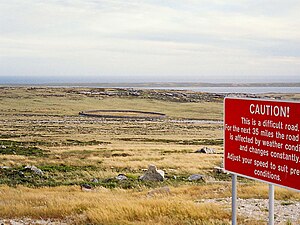Sapper Hill
| Sapper Hill | |||
| Falkland Islands | |||
|---|---|---|---|
 Gaucho stone corral at Sapper Hill (1840s) | |||
| East Falkland | |||
| Summit: | 453 feet 51°42’25"S, 57°52’12"W | ||
Sapper Hill rises to 453 feet amongst the range of hills behind Stanley, the capital of the Falkland Islands. These hills form the eastern extension of the Wickham Heights, the hills in the middle of the northern part of East Falkland.
The hill remains dangerous: it was heavily mined by the Argentine army during the Falklands War of 1982, and in spite of the long, ongoing work to clear them, Argentine landmines remain in the ground. The reason for the minefields is that Sapper Hill stands on the route to Stanley, ansd it was the scene of heavy fighting in the last days of the war.
The hill is named after a troop of sappers who were based at Moody Brook barracks.
Falklands War
Mount Tumbledown, Mount William and Sapper Hill lie west of Stanley and this proximity to Stanley, gave Sapper Hill a strategic importance. As the British forces advanced on the capital, the hills were held by the Argentines BIM-5, a reinforced, cold weather trained and equipped, marine Argentine battalion. The BIM 5 positions were bombarded, both from the sea by naval gunfire and from the air by the Royal Air Force Harriers. At 4.30 p.m., on 7 June, a British Harrier bombing positions held by the 5th Marine Battalion was hit by concentrated fire from M Company (under Marine Sub-Lieutenant Rodolfo Cionchi) on Sapper Hill.
As part of the British plan in the Battle of Mount Tumbledown, the 1st Battalion the 7th Gurkha Rifles (1/7 GR) was given the task of capturing the sub-hill of Mount William held by O Company, the 5th Marine Battalion's reserve, and then allow the Royal Marines under the command of the Welsh Guards through to seize Sapper Hill, the final obstacle before Stanley. The attacks were supported by naval gunfire from HMS Active's 4.5 inch gun. During the initial assault, Royal Marines from C company 9 troop 40 commando were dropped almost on top of the Argentine position by helicopter, resulting in a brief firefight. Three Argentine marines from 5 BIM were killed and 4 members of 9 troop were wounded - the last casualties suffered in the war.[1]
The Argentine 5th Marines worked their way back into Stanley, leaving M Company to cover the retreat. At the foot of the hill there was an extensive minefield planted by the Argentines. A group of Sappers went ahead to clear a path across the mines, but when the Welsh Guardsmen advanced they found Sapper Hill abandoned. The delay caused by the mines in fact may have saved lives. The Marine companies had been deeply entrenched and very well equipped with heavy automatic weapons. To Guardsman Tracy Evans the Sapper Hill positions looked impregnable:
'We were led to an area that the company would rest at for the night, I still took in the fact the Argies had prepared Sapper Hill well, they had depth positions that would have made the task of taking it very hard.' (Diary of Guardsman Tracy Evans, 4 Platoon, 2 Company, 1st Battalion Welsh Guards)
Ascent
The summit of Sapper Hill provides a particularly fine view over Stanley. A recommended approach from Stanley is to follow the Reservoir Road until it reaches the Stanley-Mount Pleasant road, and from hereabouts a track leads up to the hill. As with all these hills, care must be taken not to stray into a minefield, though these have been fenced off.
References
- ↑ Van Der Bijl, Nicholas & Hannon, Paul, p.8, Argentine Forces in the Falklands, Osprey Publishing Ltd, 1992, ISBN 1-85532-227-7